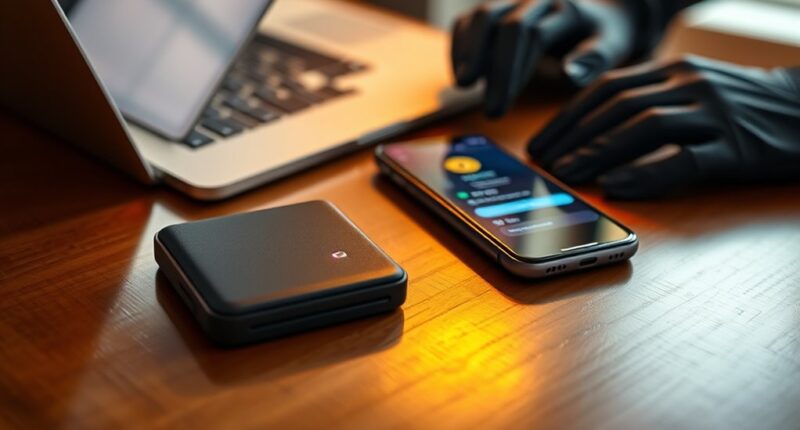To use hardware wallets with mobile apps safely, first guarantee your device is compatible and download the app from official sources. Set up strong security measures like PINs and enable biometric locks if available. Store your recovery seed securely offline and avoid connecting to public Wi-Fi networks. Always verify Bluetooth or USB connections before transactions, and keep your app updated for security patches. If you want to discover more tips for protecting your assets, continue exploring these best practices.
Key Takeaways
- Verify hardware wallet compatibility with your mobile device and OS before setup.
- Download wallet apps only from official sources and keep them updated regularly.
- Use strong PINs and enable biometric security features to protect access.
- Store recovery seed phrases securely offline and never share them digitally.
- Avoid public Wi-Fi and verify secure Bluetooth or USB connections during transactions.

Using hardware wallets with mobile apps offers a convenient way to manage your cryptocurrencies securely, but it’s essential to follow security best practices to protect your assets. One of the first steps is verifying device compatibility. Not all hardware wallets work seamlessly with every mobile device or operating system. Before purchasing or setting up a wallet, check that it’s compatible with your smartphone’s OS—whether iOS or Android—and that the mobile app supports your specific device. Compatibility issues can lead to security vulnerabilities or operational difficulties, so choosing a device that integrates smoothly reduces the risk of errors and enhances your security.
Verify hardware wallet compatibility with your device and OS before setup to ensure security and smooth operation.
Once you confirm device compatibility, focus on implementing security best practices. Always download wallet apps directly from official app stores or the manufacturer’s website to avoid fake or malicious versions. Keep your app updated to benefit from the latest security patches and features, which are indispensable for safeguarding your funds. When setting up your hardware wallet, use a strong, unique PIN or passphrase, and avoid sharing it with anyone. Enable all available security features, such as biometric authentication, if your device supports them, to add extra layers of protection.
Physical security is equally important. Store your hardware wallet in a safe, private location where it’s not accessible to others. Be cautious of phishing attempts—never click on suspicious links or provide your recovery seed to anyone. Remember, your seed phrase is the master key to your crypto assets; treat it like cash and never store it digitally or online where hackers can access it. Consider writing it down on a secure piece of paper and storing it in a safe or safety deposit box.
When connecting your hardware wallet to your mobile device, always verify that your device’s Bluetooth or USB connection is secure. Avoid public Wi-Fi networks when managing or transferring funds, as these are common targets for hackers. Use a dedicated device for crypto management if possible, to minimize exposure to malware or other threats. Regularly review transaction logs and account activity through your mobile app to catch any unauthorized access early. Additionally, understanding air purifier technologies and their features can help you create a safer, cleaner environment that supports your overall well-being while managing your crypto assets.
Frequently Asked Questions
Can I Use Multiple Cryptocurrencies With One Hardware Wallet?
Yes, you can use multiple cryptocurrencies with one hardware wallet. Many wallets offer multi-currency support, allowing you to manage various assets in a single device. This simplifies wallet management and reduces the need for multiple wallets. Just make certain your hardware wallet supports the specific cryptocurrencies you want to store, and use compatible mobile apps for smooth access. Always keep your firmware updated to maintain security across all your assets.
What Should I Do if My Hardware Wallet Is Lost or Stolen?
If your hardware wallet gets lost or stolen, act quickly by using your backup recovery seed to restore your funds on a new device. Check if your wallet provider offers insurance options for added protection, though they’re rare. Keep your recovery phrase secure and private at all times. Contact customer support for guidance, and consider monitoring your accounts for any suspicious activity to safeguard your cryptocurrencies.
Are Hardware Wallets Compatible With All Mobile Operating Systems?
Hardware wallets vary in cross platform compatibility, so you should check if they support your mobile OS, like Android or iOS. Many hardware wallets work well with multiple systems, but some have device-specific features that may limit usability. Always verify the wallet’s compatibility before purchasing, and confirm your app and firmware are updated. This way, you can securely manage your crypto assets across different mobile devices without issues.
How Often Should I Update My Hardware Wallet Firmware?
You should update your hardware wallet firmware as soon as new updates become available. Firmware updates often include important security patches that protect your assets and improve functionality. Regularly checking for updates guarantees you’re not missing critical security improvements. Don’t delay installing these updates, because outdated firmware can expose you to vulnerabilities. Stay proactive by enabling automatic updates if your device offers that feature, keeping your wallet as secure as possible.
Is It Safe to Connect My Hardware Wallet to a Public Wi-Fi Network?
Connecting your hardware wallet to a public Wi-Fi network isn’t recommended because it introduces security risks. Public Wi-Fi networks are often less secure, making it easier for hackers to intercept data or compromise your device. To protect your assets, avoid using your hardware wallet on public networks. Instead, use a secure, private connection or a trusted VPN to minimize security risks and keep your wallet and private keys safe.
Conclusion
By following these tips, you can securely use your hardware wallet with mobile apps. Always keep your recovery phrase offline and private, double-check app authenticity, and avoid connecting to unfamiliar networks. Regularly update your firmware and software to patch security vulnerabilities. With careful management and vigilance, you’ll protect your crypto assets and enjoy seamless, safe transactions on the go. Stay cautious, stay secure, and your digital assets will remain safe.









